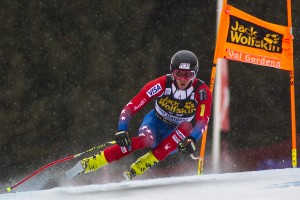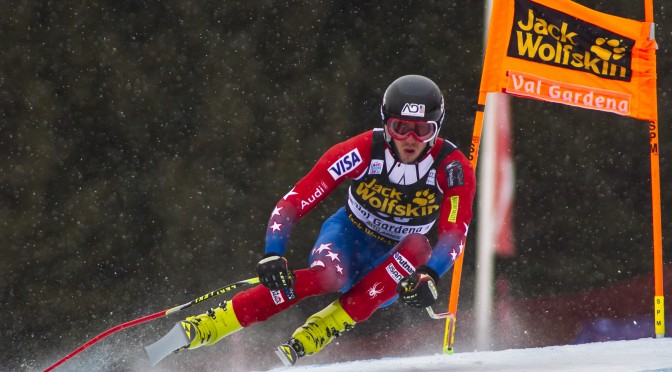Val Gardena, Italy – It was mid-afternoon at Val Gardena in the Italian Dolomites. The sun was dropping behind the Sassolungo massif, creating even more shadows along the Saslong downhill. In Santa Cristina, bands were playing as Italy celebrated downhill champion Aksel Lund Svindal of Norway.
It was well over two hours since the start. The finish crowd had thinned with just a few racers to go. Ever loyal, American stars Andrew Weibrecht, Travis Ganong, Marco Sullivan and Jared Goldberg had stuck around to cheer on one more teammate – Bryce Bennett, starting 57th.
Bryce is one of those athletes you just have to love. At first glance you would think the Squaw Valley native was a basketball star, soaring 6 feet 7 inches. But ski racing is Bryce’s passion. His sly smile, sense of humor and simply genuineness lights up the room. He’s someone you want to see have success, like his 29th and first World Cup points in Beaver Creek. That was a day for celebration!
Bryce had been nervous all week in Val Gardena. Beaver Creek was one thing – but his first trips down the Saslong that week were quite another experience.
His height had given him fits in training, trying to remain as aerodynamic as possible. Fellow tall-guy Steven Nyman, a three-time winner on the Saslong, mentored him. It was all about finding your tuck on race day – on the snow and in the air – and having direction coming out of every jump.
Earlier that morning he sat in the team hospitality area to watch the Val d’Isere women’s downhill, then went up to find a quiet place to read. His teammates were heading the to the start, but he knew he had a few more hours.
As the race rolled on, Bennett climbed onto the gondola to the start. The U.S. Ski Team’s start coach and physical therapist Tiitu Romar, herself a former World Cup racer, noticed a decided change from Bryce’s casual demeanor on training days. Today was race day, and he was laser focused. There was no toothpick and banter. “Just me and the exotics back here,” joked Bennett, referring to the odd collection of nations in the last half-dozen racers.
A lengthy crash delay had pushed his start. But now, it was time. As he looked out over the landscape, his eyes turned to the narrow swath of snow that wound its way through undulating fields, carving deep into the shadows. He was off.
The timing splits quickly told the story – strong through the wide open snowfields at the top, then continuing at speed as the course dropped into the trees and deep shadows. The eyes of his teammates grew bigger and bigger every second. “Holy crap,” said Weibrecht. “This is pretty fast.” The radio crackled: “My God, he just got into his tuck over the Mauer Jump and into the Camels,” said a startled Head Coach Sasha Rearick.
This was show time!
Through the Ciaslat and down to the final Tunnel Jump, Bennett was the picture of consistency, finding his tuck in places he never had before.

Starting 57th out of 63 racers, Bryce Bennett crossed the finish line in sixth – an eyelash away from the podium. It was a classic attack from the back from a 23-year-old kid who had just scored his first World Cup points two weeks earlier.
As a ski racer, you know when you’ve had a good run. The scoreboard only provides validation. Bennett was stunned at first – a sense of disbelief. His eyes caught his teammates, seeing them wildly screaming and pumping their fists. Veteran Marco Sullivan, who had watched Bryce grow up as kid ski racing in Tahoe, had the face of a proud dad. It was such a proud day to be from Squaw.
While it wasn’t a World Cup win or an Olympic medal, this was what Bryce Bennett had been seeking since he was a kid. He fancies himself someday as being a master craftsman in his sport and he had just created a masterpiece of a run.
“I feel my journey is a bit different than most,” Bennett said in an interview this fall defining what he feels makes a champion. “I’m not in this sport with the end goal to win medals or globes. I’m in this sport because it’s incredibly challenging with numerous variables to master.”
He credits his work ethic to his parents, who met parking cars in the Squaw Valley lot years ago. And he deeply values the lessons he learned from his coach Konrad Rickenbach. “He saved me from myself and brought me to a point where I believed in myself to become a better person.
“No one truly understands every aspect of this sport,” said the giant yeti of a ski racer. “That’s what drives me – to understand the ins and outs through self-mastery and trial and error, and one day inspire kids to go after fulfillment and passion in their work, instead of just doing whatever it takes to get to the top.”
And if you do find that mastery and passion, you’re also likely to win a few ski races.

